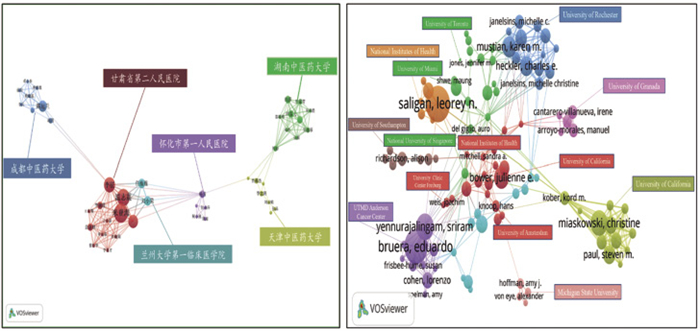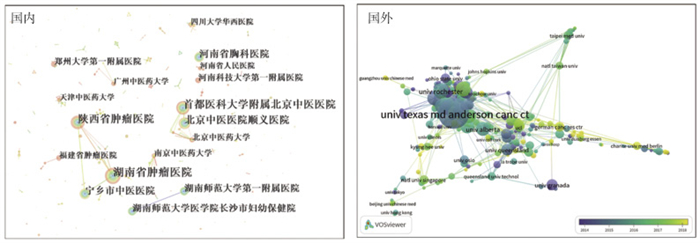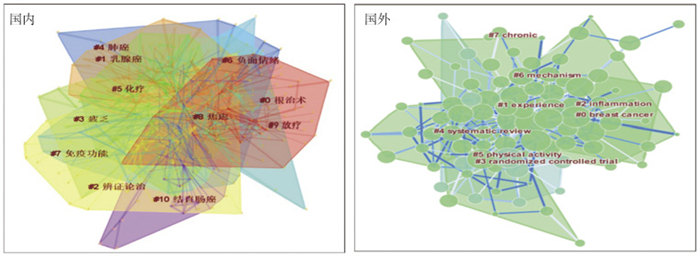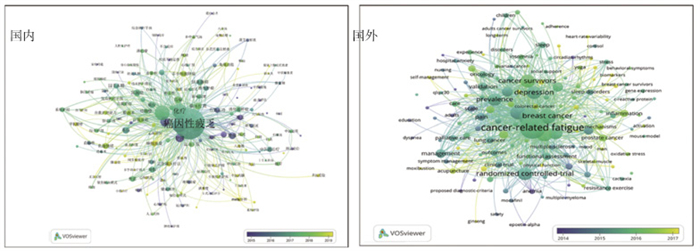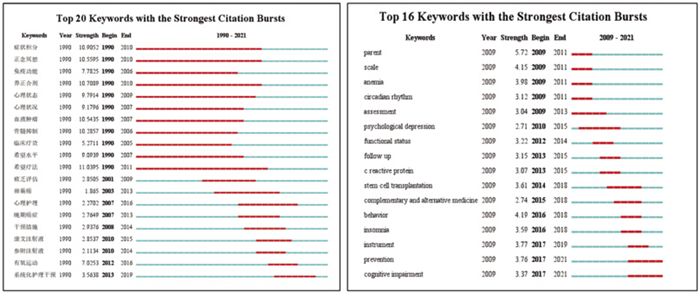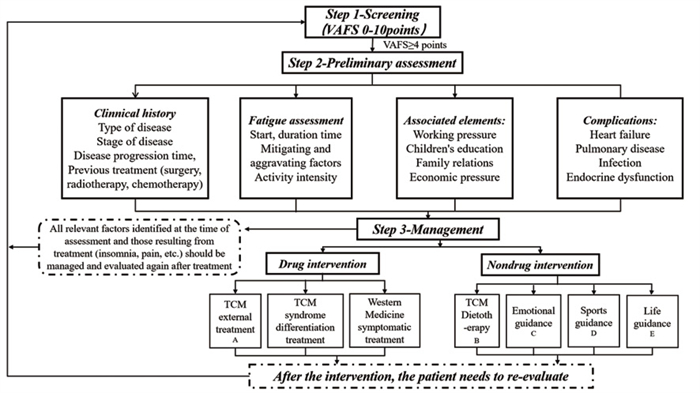Current Status, Hot Spot Discovery and Integration Prospect of Cancer-related Fatigue Research at Home and Abroad Based on Bibliometric Visualization Map Analysis
-
摘要:目的
对癌因性疲乏(CRF)国内外研究文献进行文献计量学分析,梳理国内外研究进展,呈现研究现状、分析热点演化趋势。
方法以癌因性疲乏为主题,以中国知识资源总库(CNKI)和Web of Science(WOS)核心数据库收录的有关癌因性疲乏论文为研究对象,采用VOSviewer和CiteSpace软件为研究工具,对国内外研究现状、热点演化进行可视化图谱分析。
结果(1)研究现状:①文献情况:最终纳入3646篇文献(英文1959篇,中文1687篇),中外发文量呈整体上升态势,国外基金论文占比高;②国内集中于护理与康复, 国外更广泛、多元、融合;③国内以小团体合作为主,国外跨学科、跨团队合作较多,形成了多个核心团队及研究机构群;④国内注重临床应用研究,善于借鉴国外和总结自身经验,国外更重视基础研究,治疗更系统化、规范化;⑤诊疗评估工具多样,以国外量表为主。(2)热点演化:“生活质量”一直是中外共同关注主题。国内注重临床研究,治疗上强调“审因论治”和“辨证论治”;国外重视基础研究与方法学研究,提倡运动等非药物干预;近年来补充替代医学成为国际研究热点,国内提高了对机制与方法学研究的重视,拓展了中医特色疗法在CRF中的应用。
结论中西医结合、多学科参与是CRF未来的诊疗模式,建立整合医学下中医特色非药物疗法为核心的CRF评估管理模式是未来的努力方向。
Abstract:ObjectiveTo review the research progress, present the research status and analyze the evolution trend of hot spots through the bibliometric analysis of the research literature of cancer-related fatigue(CRF) at home and abroad.
MethodsWe took CRF as the theme and the papers on CRF included in CNKI and WOS core database as the research object, and used VOSviewer and CiteSpace software as research tools, to make a visual atlas analysis on the research status and hot spot evolution at home and abroad.
Results(1)Research status: ① Literature: 3 646 papers (1 959 in English and 1 687 in Chinese) were finally included. The number of papers published at home and abroad showed an overall upward trend, and the proportion of foreign fund papers was high; ② domestic papers focused on nursing and rehabilitation. The research area of foreign papers was more extensive, diverse and integrated; ③ Domestic cooperation was mainly small group cooperation, while foreign cooperation was more interdisciplinary and cross-team cooperation, forming a number of core teams and research institutions; ④ Domestic scholars paid attention to clinical application research and were good at learning from foreign countries and summarizing own experience. Foreign scholars paid more attention to basic research and the treatment was more systematic and standardized; ⑤ There were a variety of diagnostic and therapeutic evaluation tools, mainly foreign scales. (2) Hot spot evolution: "quality of life" had always been a common topic of concern at home and abroad. Domestic scholars focused on clinical research and emphasized "treatment based on examination of causes" and "treatment based on syndrome differentiation". Foreign scholars attached importance to basic research and methodological research, and advocated non-drug intervention such as sports. In recent years, complementary and alternative medicine had become a hot topic in the international research. Domestic scholars had paid more attention to the research of mechanism and methodology, and expanded the application of TCM characteristic therapy in CRF.
ConclusionIntegrated traditional Chinese and Western medicine and multi-disciplinary participation are the future diagnosis and treatment mode of CRF. It's the direction of future efforts to establish CRF evaluation and management mode with TCM characteristic non-drug therapy as the core under integrated medicine.
-
Key words:
- Cancer-related fatigue /
- Bibliometrics /
- Visual analysis /
- CiteSpace /
- VOSviewer
-
Competing interests: The authors declare that they have no competing interests.作者贡献:谷珊珊:数据检索分析、图表绘制、论文撰写及修改王晶惠:数据检索许云:课题指导、论文审阅、统筹处理稿件
-
表 1 国内外关于CRF发文量前5名的核心期刊及基金项目
Table 1 Top five core journals and fund projects of articles about CRF at home and abroad

表 2 国内外前5名高被引CRF作者及文献排名
Table 2 Top five highly-cited authors and literatures of CRF at home and abroad

表 3 使用频次排名前8的诊疗评估工具
Table 3 Top eight frequently-used tools for diagnostic and therapeutic evaluation

表 4 国内外排名前10的关键词
Table 4 Top 10 keywords at home and abroad

-
[1] Siegel RL, Miller KD, Jemal A. Cancer statistics, 2020[J]. CA Cancer J Clin, 2020, 70(1):7-30. doi: 10.3322/caac.21590
[2] Miller KD, Nogueira L, Mariotto AB, et al. Cancer Treatment and Survivorship Statistics, 2019[J]. CA Cancer J Clin, 2019, 69(5): 363-385. doi: 10.3322/caac.21565
[3] NCCN Clinical Pratice Guildline in Oncology(NCCN Guildelines). Cancer-Related Fatigue Version 1.2021-December. Available at: https://www.nccn.org/professionals/physician_gls/pdf/fatigue.pdf
[4] Horng-Shiuann Wu, Maryellen Mcsweeney. Cancer-related fatigue: "it' s so much more than just being tired"[J]. Eur J Oncol Nurs, V2007, 11(2): 117-125. doi: 10.1016/j.ejon.2006.04.037
[5] Chen CM, Chen. CiteSpace Ⅱ: Detecting and visualizing emerging trends and transient patterns in scientific literature[J]. J Am Soc Inf Sci Tech, 2006, 57(3): 359-377. doi: 10.1002/asi.20317
[6] Scotti V. Bibliometrics and web use: the birth of altmetrics[J]. Recenti Prog Med, 2015, 106(4): 176-179.
[7] van Eck NJ, Waltman L. Citation-based clustering of publications using CitNetExplorer and VOSviewer[J]. Scientometrics, 2017, 111(2): 1053-1070. doi: 10.1007/s11192-017-2300-7
[8] 陈克能, 张力健. 癌因性疲乏[J]. 中国肿瘤临床, 1999, 26(9): 66-69. https://www.cnki.com.cn/Article/CJFDTOTAL-ZGZL199909034.htm [Cheng KN, Zhang LJ. Cancer-related Fatigue[J]. Zhongguo Zhong Liu Lin Chuang, 1999, 26(9): 66-69. ] https://www.cnki.com.cn/Article/CJFDTOTAL-ZGZL199909034.htm
[9] 朱虹玉, 张云飞, 柯熹, 等. 不同步行运动量对胃癌化疗患者癌因性疲乏影响的研究[J]. 中华护理杂志, 2021, 56(5): 652-658. doi: 10.3761/j.issn.0254-1769.2021.05.002 [Zhu HY, Zhang YF, Ke X, et al. The effect of graded walking exercise on cancer-related fatigue in patients with gastric cancer during chemotherapy[J]. Zhonghua Hu Li Za Zhi, 2021, 56(5): 652-658. ] doi: 10.3761/j.issn.0254-1769.2021.05.002
[10] 颜悦, 于晓宇, 郭姗琦, 等. 中医药治疗癌因性疲乏研究进展[J]. 天津中医药, 2019, 36(1): 96-100. https://www.cnki.com.cn/Article/CJFDTOTAL-TJZY201901025.htm [Yan Y, Yu XY, Guo SQ, et al. Research progress of traditional Chinese medicine in treatoffing the cancer-related fatigue[J]. Tianjin Zhong Yi Yao, 2019, 36(1): 96-100. ] https://www.cnki.com.cn/Article/CJFDTOTAL-TJZY201901025.htm
[11] 金铭, 谢露露, 毛妮, 等. 癌因性疲劳动物模型的研究进展[J]. 肿瘤防治研究, 2021, 48(7): 738-742. doi: 10.3971/j.issn.1000-8578.2021.21.0092 [Jin M, Xie LL, Mao N, et al. Research Progress on Animal Model for Cancer-related Fatigue[J]. Zhong Liu Fang Zhi Yan Jiu, 2021, 48(7): 738-742. ] doi: 10.3971/j.issn.1000-8578.2021.21.0092
[12] Stone PC, Minton O. Cancer-related fatigue[J]. Eur J Cancer, 2008, 44(8): 1097-1104. doi: 10.1016/j.ejca.2008.02.037
[13] Bower JE, Bak K, Berger A, et al. Screening, assessment, and management of fatigue in adult survivors of cancer: an American Society of Clinical oncology clinical practice guideline adaptation[J]. J Clin Oncol, 2014, 32(17): 1840-1850. doi: 10.1200/JCO.2013.53.4495
[14] Wang C. PG2 injection, a novel botanical drug approved for improving cancer-related fatigue among advanced cancer patients under standard palliative care: A double blind, multi-center, randomized phase Ⅳ study[J]. J Clin Oncol, 2018, 36(15): 539.
[15] Lin DJ, Culakova E, Hockler CE, et al. The association of serum ghrelin, GIP, insulin, and leptin levels with sleep quality and cancer-related fatigue in cancer survivors[J]. J Clin Oncol, 2018, 36(15_suppl): 10122. doi: 10.1200/JCO.2018.36.15_suppl.10122
[16] 李链, 朱玲慧, 曹明芹. 癌因性疲乏诊断和评估量表研究进展[J]. 新疆医学, 2016, 46(11): 1458-1461, 1465. https://www.cnki.com.cn/Article/CJFDTOTAL-XJYI201611031.htm [Li L, Zhu LH, Cao MQ. Research progress of cancer-related fatigue diagnosis and evaluation scale[J]. Xinjiang Yi Xue, 2016, 46 (11): 1458-1461, 1465. ] https://www.cnki.com.cn/Article/CJFDTOTAL-XJYI201611031.htm
[17] Shun SC, Beck SL, Pett MA, et al. Psychometric testing of three Chinese fatigue instruments in Taiwan[J]. J Pain Symptom Manage, 2006, 32(2): 155-167. doi: 10.1016/j.jpainsymman.2006.02.011
[18] 任似梦, 吴晓月, 周慧灵, 等. 癌因性疲乏患者报告结局评估工具研究进展[J]. 世界中医药, 2021, 16(13): 1928-1931, 1936. doi: 10.3969/j.issn.1673-7202.2021.13.002 [Reng SM, Wu XY, Zhou HL, et al. Research Progress of Patient-reported Outcome Measures for Patients with Cancer-Related Fatigue[J]. Shi Jie Zhong Yi Yao, 2021, 16(13): 1928-1931, 1936. ] doi: 10.3969/j.issn.1673-7202.2021.13.002
[19] Bower, Julienne E. Cancer-related fatigue-mechanisms, risk factors, and treatments[J]. Nat Rev Clin Oncol, 2014, 11(10): 597-609. doi: 10.1038/nrclinonc.2014.127
[20] 龚轩, 吴瑞婷. 《伤寒论》五脏"脏结"对肿瘤治疗的指导意义[J]. 中医杂志, 2019, 60(20): 1737-1740. https://www.cnki.com.cn/Article/CJFDTOTAL-ZZYZ201920008.htm [Gong X, Wu RT. Guiding significance of " Zang Jie" of five zang organs in Treatise on Febrile Diseases for tumor treatment[J]. Zhong Yi Za Zhi, 2019, 60(20): 1737-1740. ] https://www.cnki.com.cn/Article/CJFDTOTAL-ZZYZ201920008.htm
[21] Arring NM, Barton DL, Brooks T, et al. Integrative Therapies for Cancer-Related Fatigue[J]. Cancer J, 2019, 25(5): 349-356. doi: 10.1097/PPO.0000000000000396
[22] Fabi A, Bhargava R, Fatigoni S, et al. Cancer-related fatigue: ESMO Clinical Practice Guidelines for diagnosis and treatment[J]. Ann Oncol, 2020, 31(6): 713-723. doi: 10.1016/j.annonc.2020.02.016



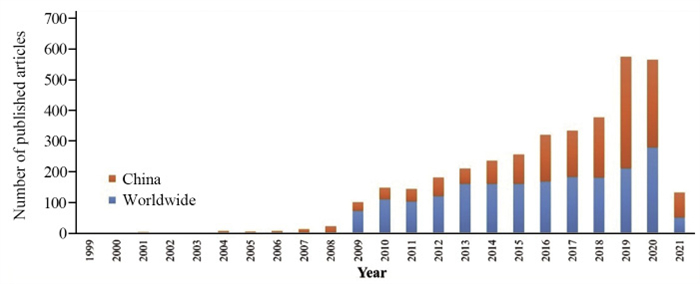
 下载:
下载:
